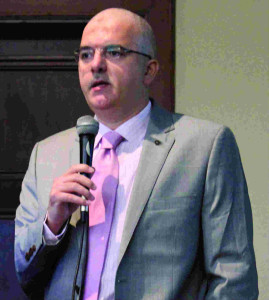Expecting the Gulf air conditioning market to fully embrace VRF technology in the coming years, SKM launches two new product lines.
A must for the coming period – this was how Nabil Abouseido, Marketing and Business Development Director at SKM Air Conditioning, described VRF technology in the opening speech he delivered on the first day of a four-day seminar his company organised in January 17 to 20. Held in Sharjah, UAE, the event served as the launch of SKM’s two new ranges of VRF systems, as well as a training programme for the company’s distributors and partners.
Abouseido, explaining his claim, cited increasing interest in the issue of energy efficiency as the primary factor spurring the growth of the VRF market in the Middle East. “Because of energy concerns, the market is moving in the direction of VRF,” he said. “SKM has to move with the market, which is why we have decided to include VRF in our unitary business line-up.”

Fady Nassar, Director of Unitary Business at SKM
Alternative solution
In his welcome remarks, Fady Nassar, Director of Unitary Business at SKM, backed Abouseido’s statement by announcing the company’s intention to commit to VRF technology and encouraged everyone present to do the same.
“SKM has not carried VRF in its product portfolio,” Nassar said. “But starting this year onwards, we are going to embrace VRF big time. In fact, we want us all to embrace VRF, and this is why we are not only launching two new series – the Avalanche or our digital scroll series and the Specter, which is our DC inverter series – but also conducting this training programme.”
The aim of the training seminar, Nassar told those in attendance, was to give them an in-depth understanding of product features and all the technical details of VRF as well as discuss selling points and the selection software, among other things. He then enjoined them to “start specifying and quoting VRF to customers and consultants, because it’s going to be a wonderful alternative to so many existing conventional air conditioning systems”.
Trends and challenges
Nassar, speaking with Climate Control Middle East on the sidelines of the event, disclosed that while regional focus on energy efficiency is a huge factor behind the anticipated increase in market demand for VRF technology, trends in the global market are also influencing the decisions of the GCC region’s HVAC industry.
“Market trends around the world are driving VRF,” he said. “In North African countries, VRF makes up majority of the HVAC market. The same is true in Turkey, Iran and Pakistan. In India, VRF is also a big deal, and in the GCC [region], 10-15% of the market is now being specified as VRF. So VRF is no longer a choice but a necessity for every single HVAC company. They all have to embrace VRF; otherwise, they could easily be out of the market in the coming five years.”
Despite his positive assessment of the global demand for the technology, he admitted that the use of VRF systems is not without its share of challenges. “The challenges are still there, with one being installation,” said Nassar. “VRF systems are actually easy to install, because they are lightweight and modular, but not just any MEP contractor can do it. You need to have highly trained and experienced people handling the installation to ensure that the system set-up is completed properly, that the controls are managed right and that all the components in the system ‘talk’ to each other.”
The second challenge is safety, he revealed, elaborating: “ASHRAE has identified a [concentration] limit for refrigerants, so whenever you’re designing a VRF system, you need to make sure that the quantity of the refrigerant that would run on the pipes meets the limit identified.”
Naming initial cost as the third challenge, Nasser stated that while “the mid-range is dominated by conventional DX and chilled-water systems, they could easily be replaced with VRF products”. He added, “In terms of costs, though, VRF systems would be considered more expensive than conventional systems.”
To convince clients to still go for VRF, he suggested that all costs involved in the use of the system must be taken into account. “The proper way of selling VRF,” he said, “is to check the complete life-cycle cost of the project, including the initial, installation, maintenance and running costs. Calculations should cover a period of 20-25 years, and then compared to total user costs for conventional systems. Clients will surely find that VRF systems are more accessible.”
Opportunity in downtime
Having acknowledged that clients do tend to engage in system-to-system comparison of capital costs, Nassar shared the information that the continued drop in oil prices – and its impact on the industry – was factored into SKM’s decision to introduce two new product lines, but not as a deterrent.
“Frankly speaking, when we thought of launching the products,” said Nassar, “we felt that it was necessary to do it now, because we don’t want to be left behind. Is 2016 the right time? I believe it is, because it doesn’t matter if the economy is up or down. If you don’t have the technology, you won’t be part of the conversation. And yes, people usually focus on CAPEX, but if consultants, owners and developers would learn to think of long-term benefits and of the environment, this downtime in the economy could be an opportunity for the VRF business to grow. People would realise that they need to install sustainable systems and that VRF is the answer.”
Copyright © 2006-2025 - CPI Industry. All rights reserved.